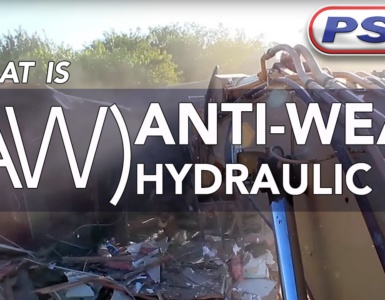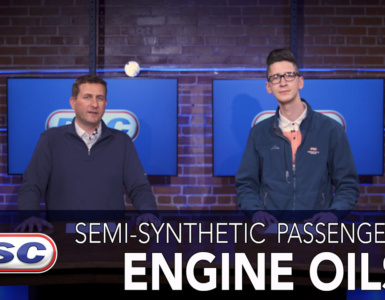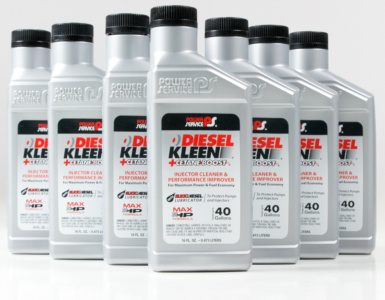Hydraulic Fluids are vitally important on a job site as they transfer power from one location to another in heavy equipment essential to getting the job done, and also serve to lubricate moving parts and transfer heat. Quality conventional petroleum based and synthetic hydraulic oils like polyglycols and esters are appropriate in many situations, but should a job site be near environmentally sensitive areas like aquatic habitats and water sources different considerations are in play. To both protect ocean wildlife and limit job site liability a project manager should consider the use of a conventional vegetable oil-based hydraulic fluid for best management practice (BMP).
The three main characteristics that the EPA uses to gauge the environmental impacts of hydraulic oils are the potential for bioaccumulation, biodegradability of the substance, and aquatic toxicity. Here are definitions summarized from the EPA report, Environmentally Acceptable Lubricants, and reflections on how they should inform hydraulic lubricant selections in environmentally sensitive areas
Potential for Bioaccumulation: Bioaccumulation is the build-up of chemicals within the tissue of an organism over time. The longer the organism is exposed to a chemical and the longer the organism lives, the greater the accumulation of the chemical in the tissues. If the chemical has a slow degradation rate or low depuration rate within an organism, concentrations of that chemical may build-up in the organisms tissues and may eventually lead to adverse biological effects. According to the California Coastal Commission, Water Quality Fact Sheet Series, “petroleum-based hydraulic fluids have a potential for bioaccumulation, but non-petroleum hydraulic fluids (vegetable oils, polyglycols, and synthetic esters) do not.”
Biodegradability: Biodegradability is a measure of the breakdown of chemical (or a chemical mixture) by micro-organisms (EPA EAL Report). Biodegradability is broken down into several different characteristics that can often be confusing. It is easier to look at these qualifiers as two sets of terms that classify biodegradability. The first set is primary and ultimate biodegradation. Primary biodegradation “is the loss of one or more active groups in a chemical compound that renders the compound inactive with regard to a particular function.” Ultimate biodegradation or mineralization is “the process whereby a chemical compound is converted to carbon dioxide, water, and mineral salts.” The second set that defines biodegradability is inherently and readily biodegradable. “A compound is considered inherently biodegradable so long as it shows evidence of biodegration in any test for biodegradability. Readily biodegradable is an operational definition that some fraction of a compound is ultimately biodegradable within a specific timeframe, as specified by a test method.” The takeaway from this data is that if a job is near a environmentally sensitive area it is best to use a hydraulic fluid that is readily biodegradable. This is supported by the California Coastal Commission report which states that “biodegradable hydraulic fluids do not persist as long in the environment as non-biodegradable products, which is likely to lessen the environmental impact of spills. Petroleum-based hydraulic oils are not readily biodegradable. In contrast, vegetable-oil based hydraulic fluids are readily biodegradable.”
Aquatic Toxicity: Aquatic Toxicity is the ability of a substance to cause harmful effects on an aquatic organism, ranging from physiological and behavioral effects to mortality. “In general, the vegtable oil and synthetic ester base oil have a low toxicity to marine organisms” (EPA EAL Report). Vegtable based oils are also compatible with mineral based as apposed to polyglycos, which cannot be interchanged without a system flush out with equipment that runs on petroleum based products.
Although some synthetic hydraulic fluids like polyglycols and esters are biodegradable they are more expensive then vegetable oil-based hydraulic fluids and not readily biodegradable across the board. With these facts in mind the California Coastal Commission offered a recommendation in support of the use of vegetable-based hydraulic fluids in heavy equipment for construction in or near sensitive aquatic habitats. Their final consensus was that although the synthetic hydraulic fluids are a better choice than petroleum-based hydraulic fluids, vegetable oil-based hydraulic fluids are the best choice for the situation.
It can be a maze as a buyer trying to procure Environmentally Acceptable Lubricants (EAL’s) for equipment as there is not yet a formal standard across the board. With a slew of different regulations, technical specs, and varying standards of biodegradability in this new landscape it is important to turn to the EPA’s Environmentally Acceptable Lubricants Report and the different international standards that it references along with the nuts and bolts information on product data sheets. Always remember to find a reputable distributor with the knowledge to guide your organization through the proper buying process to ensure best management practices to protect your company and our beautiful earth and its waterways.
Please Click on the References below for more in depth information:
EPA, Environmentally Acceptable Lubricants Report, Nov 2011
California Coastal Commission, Water Quality Fact Sheet, Spring 2012
Note: This article is compiled by “A Petroleum Service” staff. It is not a finding by “A Petroleum Service,” and the information may be superseded by site-specific information from the referenced sources.
Questions or Comments: Post Below
From the team of experts at The PSC Online Store








Water soluble PAG are as biodegradable as vegetable oils, have a much higher level of performance all around ( far superior oxidation & thermal stability, VI, do not turn acidic and cannot form varnish and have superior friction co-effecientcies and load carrying properties than conventional or other EALs.Contrary to popular belief, PAGs can be engineered in a variety of different ways and products such as Dow UCON Trident and ACT’s Neptune products have excellent seal compatibility.
The one thing that is always forgotten is why do you choose an EAL in the first place, other that the EPA says “you gotta”, or “the boss says so”. Isn’t it to reduce and or eliminate oil spill clean up costs, redemption, liabilities and fines?
The ‘Clean Water AcT of 1990″ and 40 CFR 435, the no-sheen rule, state that ALL oil, mineral or vegetable oil are prohibited from being discharged into the water in any of the contiguous United States.
This is why companies still get large fines for spilling oil, even when it is an approved EAL. So why would you spend all that time and money to convert equipment to a product that will still get you fined?
Further more vegetable oil and even synthetic esters are still prone to oxidation and have lesser thermal limits than mineral oils, requiring them to be changed much more frequently, and are usually not effective in cold temperatures. Vegetable and vegetable esters have poor tolerance for moisture and will turn acidic and gummy in the presence of moisture.
Water soluble PAG are inert to water, will tolerate far more water ingression than any other type of lubricant and have fluid life spans far longer that that of conventional mineral oils.
Water soluble PAG are not classified as “Oil” and subsequently, spills are not a violation of the Clean Water Act and the non-sheening rule, and since they dissolve and dissipate in water, do not require cleanups. The product continues to dissipate and will not oil birds or shorelines and is practically non-toxic to begin with. Biodegradability if about 80% in 28 days OECD 301F.
Why would you invest in an EPA Approved EAL (PAG are EPA approved) that will still be a cause of environmental liability and also present other headaches for the equipment maintenance people?
The main problem is that there is a lot of bias towards PAGs in general, as most tribologists are not at all familiar with these products at all and there are a lot of false assumptions about them. It is also ignorance of some of the new technology available, the ignorance of environmental legislation, and the fact that most oil companies push oil, what else? PAGs are generally manufactured by companies such as Dow Chemical and BASF, to name a couple, but it it time that big oil woke up, read the environmental regulations and actually paid some attention to these types of products.
PAGs are the ‘Ideal EAL”.